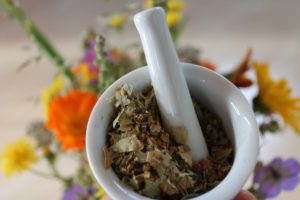Gemmotherapy For Pets

Sometimes I consider myself a natural health nerd. For example, I am simply fascinated by the healing power of plants, and many people probably think this is weird. Nonetheless, today I am excited about a special type of herbal medicine: gemmotherapy, also known as plant stem cell therapy. This powerful form of herbal therapy is another great tool you can put in your holistic health toolbox. (Yes, it’s also good for people, too.)
What is gemmotherapy?
I had never even heard of gemmotherapy until my client, Christine, told me about it. An article by I & E Organics Apothecary describes it this way:
Gemmotherapy is a form of herbal medicine prompted by principals of homeopathic drainage and stimulation and regeneration of cells, tissues and organs, uses freshly harvested embryonic tissue of trees and shrubs ~ plant bud extracts, shoots, rootlets, seeds, bark and in a few cases sap.
This raw material is taken at the peak time of the tree or shrub’s annual germination in the spring for buds or the autumn for seeds. Certain plant hormones and enzymes are released during this process, and in some cases are only present in the plant at this time.
Unlike mature plants, embryonic plant tissue includes high amounts of growth factors such as phyto hormones, auxins and gibberellins. These substances stimulate cell growth, RNA and protein synthesis.
How are gemmotherapies made?
If you are familiar with homeopathy, the answer to how gemmotherapies are made will sound very similar. Expert in gemmotherapy, Daniel Towle, D.C., DNBHE, describes it this way:
As soon as they are harvested, the bud and embryonic plant tissue are soaked in a mixture of glycerin and alcohol, in a ratio of 1/20 of the dry weight of the fresh plant used. Glycerin is selected as an excipient as it allows for better extraction of the embryonic ingredients. After three weeks, the macerate is filtered and diluted to 1/10 with a mixture of water, alcohol and glycerin.

What are gemmotherapies used for?
Towle further describes the use of gemmotherapy for drainage and detoxification utilizing organs or parts of the body that carry off waste.
Phytoembryotherapy, also known as gemmotherapy, is very close in concept to homeopathic therapy due to this drainage capacity. Three types of this modern method of drainage have been distinguished:
1. Drainage by means of organ stimulation.
2. Drainage by means of tissue excitation.
3. Drainage by means of toxin elimination.
How do gemmotherapies work for pets?
Despite the fact that gemmotherapies have most commonly been used by people, they can work just as well with animals. You simply adjust the dosage. I watched a video this week of a professional herbalist, Rita Hogan, who works exclusively with dogs. She discussed indications for using three specific gemmotherapies: Common Juniper, Rosemary and Birch.
For example, Common Juniper has an affinity for the liver, kidneys and skin. Conditions that Juniper improves include solid tumors, fatty lipomas, food allergies, seasonal allergies, leaky gut, malabsorption and as an anti-inflammatory.
Another example is Rosemary. This plant stem cell works as a protector being naturally high in antioxidants. It has an affinity for the liver, gallbladder and nervous system and is ideal for use with chronic allergies, stiff hips and neck, and balancing hormones.
Finally, Birch has even more indications. It’s ideal for destroying infections, supporting the spleen, immune system function, auto-immune disease, heavy steroid use and even rabies vaccinosis. Additionally, birch removes anesthesia, addresses thyroid imbalances, gallbladder, digestion, food sensitivities, leaky gut and even kidney imbalance/disease. As a systemic pain reliever, it is beneficial for joint pain, arthritis and other musculoskeletal conditions.
Interestingly, Hogan mentioned that for pets currently taking Prednisolone/Prednisone, the Black Currant remedy can be a great substitute.
How to use gemmotherapy
These amazing plant therapies can be put in the mouth, in food or transdermally. Generally, for a 10X or 1D potency you would use 1 drop per 10 pounds. For Rosemary, because it is so powerful use only 1 drop per 25 pounds.
Adverse effects can include sebaceous cysts and nausea, and if nausea persists be sure to discontinue the remedy. To help guide you in their use, find an herbalist who is familiar with gemmotherapy or use muscle testing to determine which remedies resonate with you or your pet. Furthermore, muscle testing is a great way to determine dosage protocols.
Having a cat with chronic seasonal allergies and a previous nasal polyp, I’m giving gemmotherapy a try. I ordered a bottle of Rosemary for my cat Rocket, I look forward to see how well his immune system responds! Stay tuned for updates.
In conclusion, Towle feels that using gemmotherapy helps speed up the recovery process because it works so well in promoting detoxing and opening up the drainage pathways throughout the body. If you’re open to using a different form of herbal medicine consider giving gemmotherapy a try.
Have you tried a gemmotherapy for your cat? Share in the comments below!

